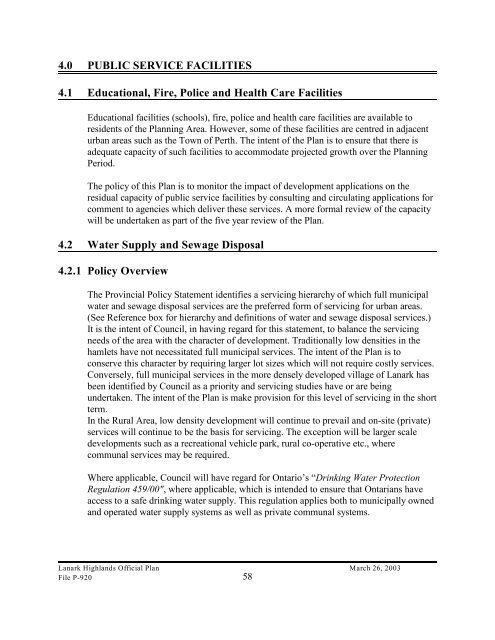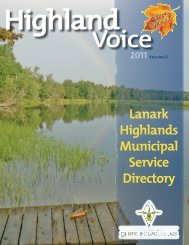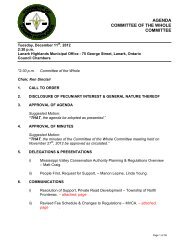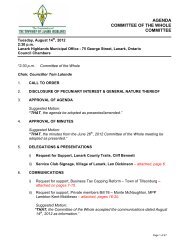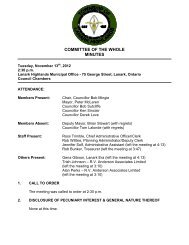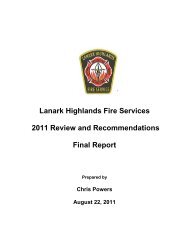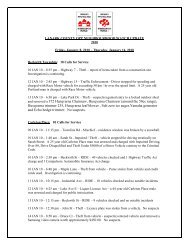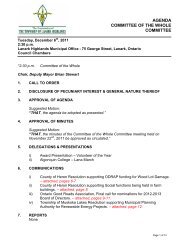Section 4 - the Township of Lanark Highlands
Section 4 - the Township of Lanark Highlands
Section 4 - the Township of Lanark Highlands
Create successful ePaper yourself
Turn your PDF publications into a flip-book with our unique Google optimized e-Paper software.
4.0 PUBLIC SERVICE FACILITIES<br />
4.1 Educational, Fire, Police and Health Care Facilities<br />
Educational facilities (schools), fire, police and health care facilities are available to<br />
residents <strong>of</strong> <strong>the</strong> Planning Area. However, some <strong>of</strong> <strong>the</strong>se facilities are centred in adjacent<br />
urban areas such as <strong>the</strong> Town <strong>of</strong> Perth. The intent <strong>of</strong> <strong>the</strong> Plan is to ensure that <strong>the</strong>re is<br />
adequate capacity <strong>of</strong> such facilities to accommodate projected growth over <strong>the</strong> Planning<br />
Period.<br />
The policy <strong>of</strong> this Plan is to monitor <strong>the</strong> impact <strong>of</strong> development applications on <strong>the</strong><br />
residual capacity <strong>of</strong> public service facilities by consulting and circulating applications for<br />
comment to agencies which deliver <strong>the</strong>se services. A more formal review <strong>of</strong> <strong>the</strong> capacity<br />
will be undertaken as part <strong>of</strong> <strong>the</strong> five year review <strong>of</strong> <strong>the</strong> Plan.<br />
4.2 Water Supply and Sewage Disposal<br />
4.2.1 Policy Overview<br />
The Provincial Policy Statement identifies a servicing hierarchy <strong>of</strong> which full municipal<br />
water and sewage disposal services are <strong>the</strong> preferred form <strong>of</strong> servicing for urban areas.<br />
(See Reference box for hierarchy and definitions <strong>of</strong> water and sewage disposal services.)<br />
It is <strong>the</strong> intent <strong>of</strong> Council, in having regard for this statement, to balance <strong>the</strong> servicing<br />
needs <strong>of</strong> <strong>the</strong> area with <strong>the</strong> character <strong>of</strong> development. Traditionally low densities in <strong>the</strong><br />
hamlets have not necessitated full municipal services. The intent <strong>of</strong> <strong>the</strong> Plan is to<br />
conserve this character by requiring larger lot sizes which will not require costly services.<br />
Conversely, full municipal services in <strong>the</strong> more densely developed village <strong>of</strong> <strong>Lanark</strong> has<br />
been identified by Council as a priority and servicing studies have or are being<br />
undertaken. The intent <strong>of</strong> <strong>the</strong> Plan is make provision for this level <strong>of</strong> servicing in <strong>the</strong> short<br />
term.<br />
In <strong>the</strong> Rural Area, low density development will continue to prevail and on-site (private)<br />
services will continue to be <strong>the</strong> basis for servicing. The exception will be larger scale<br />
developments such as a recreational vehicle park, rural co-operative etc., where<br />
communal services may be required.<br />
Where applicable, Council will have regard for Ontario’s “Drinking Water Protection<br />
Regulation 459/00", where applicable, which is intended to ensure that Ontarians have<br />
access to a safe drinking water supply. This regulation applies both to municipally owned<br />
and operated water supply systems as well as private communal systems.<br />
<strong>Lanark</strong> <strong>Highlands</strong> Official Plan March 26, 2003<br />
File P-920 58
Hierarchy <strong>of</strong> Sewage and Water Disposal Systems<br />
Sewage and water systems:<br />
Full municipal sewage and water services:<br />
means piped sewage and water services that are connected to a centralized water and waste<br />
water treatment facility.<br />
Communal services:<br />
means sewage works and sewage systems, and water works that provide for <strong>the</strong> distribution,<br />
collection or treatment <strong>of</strong> sewage or water but which:<br />
• are not connected to full municipal sewage and water services;<br />
• are for <strong>the</strong> common use <strong>of</strong> more than five residential units/lots; and<br />
• are owned, operated, and managed by:<br />
• <strong>the</strong> municipality; or<br />
• ano<strong>the</strong>r public body; or<br />
• a condominium corporation or single owner which has entered into an<br />
agreement with <strong>the</strong> municipality or public body, pursuant to <strong>Section</strong> 51 <strong>of</strong> <strong>the</strong><br />
Planning Act, providing for municipal/public body assumption <strong>of</strong> <strong>the</strong><br />
communal services in <strong>the</strong> event <strong>of</strong> default by <strong>the</strong> owner.<br />
Individual on-site systems:<br />
means individual autonomous water supply and sewage disposal systems, that are owned,<br />
operated and managed by <strong>the</strong> owner <strong>of</strong> <strong>the</strong> property upon which <strong>the</strong> system is located and<br />
which do not serve more than five residential units/lots.<br />
Partial services:<br />
means connection to one communal service or full municipal service where <strong>the</strong> o<strong>the</strong>r<br />
connection will be to an individual on-site system.<br />
Source: Provincial Policy Statement<br />
<strong>Lanark</strong> <strong>Highlands</strong> Official Plan March 26, 2003<br />
File P-920 59
4.2.2 Municipal Water and Sewer Services<br />
It is <strong>the</strong> policy <strong>of</strong> Council to ensure that <strong>the</strong> density <strong>of</strong> development within <strong>the</strong> Planning<br />
Area does not result in <strong>the</strong> need for piped water and sewer services in Hamlets. In <strong>the</strong><br />
review <strong>of</strong> Planning applications, it is Council’s intent to ensure that <strong>the</strong> lot sizes are<br />
sufficiently large to make <strong>the</strong>m self-sustaining for <strong>the</strong> purposes <strong>of</strong> water supply and<br />
sewage disposal. In <strong>Lanark</strong> village, <strong>the</strong> intent <strong>of</strong> Council is to provide for full municipal<br />
(piped) services and is currently working towards that end. Once installed, existing and<br />
new development will be expected to connect to <strong>the</strong>se services.<br />
In <strong>the</strong> selection <strong>of</strong> a site for a municipal sewage disposal system (e.g. waste stabilization<br />
lagoon) and in making planning decisions on development in <strong>the</strong> vicinity <strong>of</strong> such a site<br />
after installation, Council will ensure that an adequate separation distance is established<br />
to mitigate odour and/or o<strong>the</strong>r impacts <strong>of</strong> <strong>the</strong> sewage disposal system on sensitive land<br />
uses (see definition in <strong>Section</strong> 3.5.3 (4)].<br />
Reference should be made to <strong>the</strong> Ministry <strong>of</strong> <strong>the</strong> Environment’s Guideline D-1, Land<br />
Use Compatibility and Guideline D-2, Compatibility between Sewage Treatment and<br />
Sensitive Land Uses in establishing separation distances.<br />
4.2.3 Individual On-Site Systems<br />
1. Lands throughout <strong>the</strong> Planning Area may currently be serviced by individual onsite<br />
(private) sewage disposal systems. Planning applications for new<br />
development shall be supported by a terrain analysis or an assimilation capacity<br />
study satisfactory to meeting <strong>the</strong> approval requirements <strong>of</strong> <strong>the</strong> Environmental<br />
Protection Act: e.g.<br />
A. Where <strong>the</strong> total effluent discharged by one or more sewage systems is<br />
10,000 litres/day (2,200 gallons/day) or less, and <strong>the</strong> system(s) will be<br />
entirely within <strong>the</strong> bounds <strong>of</strong> <strong>the</strong> lot, <strong>the</strong> approvals will be governed by <strong>the</strong><br />
Building Code Act.<br />
B. Where <strong>the</strong> total effluent discharged by one or more sewage systems is<br />
greater than 10,000 litres/day (2,200 gallons/day), <strong>the</strong> approval authority<br />
will be <strong>the</strong> Ministry <strong>of</strong> <strong>the</strong> Environment. The associated hydro-geological<br />
study shall demonstrate soil suitability, sufficient area for effluent<br />
treatment and site suitability for <strong>the</strong> disposal system.<br />
C. A water supply assessment report may be required for proposals using a<br />
<strong>Lanark</strong> <strong>Highlands</strong> Official Plan March 26, 2003<br />
File P-920 60
groundwater source i.e. well, to demonstrate that <strong>the</strong>re is an adequate<br />
supply (quantity and quality) and that <strong>the</strong>re will be no interference from<br />
sewage disposal or draw down <strong>of</strong> <strong>the</strong> water table.(Reference should be<br />
made in this regard to <strong>the</strong> Ministry <strong>of</strong> <strong>the</strong> Environment’s “Technical<br />
Guideline for Individual On-Site Sewage Systems: Water Quality Impact<br />
Risk Assessment”.) Consideration shall be given to <strong>the</strong> cumulative impact<br />
<strong>of</strong> development on <strong>the</strong> available water supply. A water budget for users<br />
may be required in this regard.<br />
2. For plans <strong>of</strong> subdivision, a servicing options report in accordance with Ministry <strong>of</strong><br />
<strong>the</strong> Environment Guidelines will be required.<br />
3. Well construction standards will be required to meet Ontario Regulation 903 for<br />
lands serviced with an on-site (private) water supply (i.e. well).<br />
4.2.4 Communal Services<br />
Council may consider communal services (water and/or sewage) for multiple lot/unit<br />
development (more than five lots/units).<br />
Prior to considering <strong>the</strong> need for a communal system, Council shall be satisfied that <strong>the</strong><br />
following criteria are considered:<br />
1. That <strong>the</strong> proposed density <strong>of</strong> development is essential to <strong>the</strong> viability <strong>of</strong> <strong>the</strong><br />
project and that o<strong>the</strong>r development or servicing options have been thoroughly<br />
considered i.e. different location, method <strong>of</strong> servicing, acquisition <strong>of</strong> a larger land<br />
holding etc., and that as a result, <strong>the</strong> only reasonable or economical alternative is a<br />
communal system.<br />
2. That <strong>the</strong> potential for remedial measures has been adequately investigated with<br />
respect to health related matters i.e. well contamination, nutrient management, and<br />
that no reasonable or economical alternative exits for resolving such health<br />
concerns than to install a communal system.<br />
3. That <strong>the</strong> Ministry <strong>of</strong> <strong>the</strong> Environment has issued an order under <strong>the</strong><br />
Environmental Protection Act requiring <strong>the</strong> installation <strong>of</strong> a communal system<br />
and/or <strong>the</strong> proposed communal system qualifies for Certificate <strong>of</strong> Approval from<br />
<strong>the</strong> Ministry.<br />
4. That <strong>the</strong> proposed owner/operator has prepared an appropriate business plan to<br />
establish an appropriate cost structure for <strong>the</strong> installation and operation <strong>of</strong> <strong>the</strong><br />
communal system(s).<br />
<strong>Lanark</strong> <strong>Highlands</strong> Official Plan March 26, 2003<br />
File P-920 61
5. That a financial security can be established i.e. trust fund, to <strong>of</strong>fset potential<br />
capital or operational costs arising from <strong>the</strong> default <strong>of</strong> <strong>the</strong> operator.<br />
Where such a system is deemed to be necessary based on <strong>the</strong> above criteria and is<br />
approved, Council will assume responsibility or ownership after <strong>the</strong> issuance <strong>of</strong> a<br />
Certificate <strong>of</strong> Approval. (Note: this may include a Permit to Take Water under <strong>the</strong><br />
Ontario Water Resources Act.) Council may choose to operate <strong>the</strong> system or may<br />
consider entering into a legal agreement for <strong>the</strong> operation and maintenance <strong>of</strong> <strong>the</strong> system<br />
on a private basis subject to <strong>the</strong> approval <strong>of</strong> <strong>the</strong> Ministry <strong>of</strong> <strong>the</strong> Environment. The legal<br />
agreement shall contain financial assurance provisions which will ensure funds for<br />
operation and routine maintenance as well as a secured fund for capital improvements<br />
should repair or replacement <strong>of</strong> <strong>the</strong> facility become necessary. In addition, <strong>the</strong> legal<br />
agreement shall set out <strong>the</strong> following:<br />
1. Operating and Maintenance Standards.<br />
2. A definition <strong>of</strong> Default.<br />
3. An outline <strong>of</strong> remedial action.<br />
4. Registration on title <strong>of</strong> <strong>the</strong> subject property.<br />
5. Easements, where required.<br />
Council will assume responsibility for <strong>the</strong> communal system should <strong>the</strong> system fail or<br />
should <strong>the</strong> operator fail to operate or maintain <strong>the</strong> system according to <strong>the</strong> agreement and<br />
will utilize <strong>the</strong> financial security as needs be in <strong>the</strong> operation/repair <strong>of</strong> <strong>the</strong> communal<br />
system.<br />
For <strong>the</strong> purposes <strong>of</strong> this Plan, Communal Services means sewage works and sewage<br />
systems and water works that provide for <strong>the</strong> distribution, collection or treatment <strong>of</strong><br />
sewage or water, but which are not connected to full municipal sewage and water<br />
services; are for <strong>the</strong> common use <strong>of</strong> more than five residential or non-residential lots or<br />
units; and are owned, operated, and managed by <strong>the</strong> municipality, ano<strong>the</strong>r public body, a<br />
condominium corporation or single owner under an agreement pursuant to <strong>the</strong> Planning<br />
Act.<br />
4.3 Storm Water Management and Drainage<br />
It is Council’s policy that storm water management shall be required for development<br />
principally in built-up areas such as <strong>the</strong> village or hamlets and for major rural<br />
development including all subdivisions, industrial, commercial and golf course<br />
developments as a preventative approach (ra<strong>the</strong>r than relying solely on end-<strong>of</strong>-pipe<br />
quality control) to protecting water resources (quality and quantity).<br />
The principles which Council intends to utilize in its approach to storm water<br />
<strong>Lanark</strong> <strong>Highlands</strong> Official Plan March 26, 2003<br />
File P-920 62
management are listed as follows:<br />
1. That natural hydrological characteristics are maintained, and where possible,<br />
enhanced as <strong>the</strong> means to protecting <strong>the</strong> base flow <strong>of</strong> watercourses.<br />
2. That <strong>the</strong> natural infiltration <strong>of</strong> water on lands which are developed, is maximized.<br />
3. That proposed development will not result in increased downstream flooding or<br />
erosion or cause adverse effects on receiving waters.<br />
4. To ensure that alterations to natural drainage systems are prohibited or at least<br />
minimized by maximizing <strong>the</strong> retention <strong>of</strong> natural vegetation and by leaving<br />
stream channels in <strong>the</strong>ir natural form.<br />
5. That fish and wildlife habitat are protected, enhanced or restored including habitat<br />
linkages where affected by <strong>the</strong> discharge or outlet <strong>of</strong> drainage facilities.<br />
6. That a sustainable environmental approach is utilized in protecting water<br />
resources.<br />
7. That water quality will be monitored on an ongoing basis as <strong>the</strong> means to<br />
evaluating <strong>the</strong> effectiveness <strong>of</strong> storm water management practices.<br />
It is <strong>the</strong> intent <strong>of</strong> Council to incorporate storm water management controls into <strong>the</strong><br />
development review and approval process. Proponents <strong>of</strong> development will be required to<br />
plan for and undertake storm water management which complies with <strong>the</strong> above<br />
principles. This may require a sub-watershed management plan for large tracts <strong>of</strong> land or<br />
a storm water site management plan. Proponents should utilize best management<br />
practices where <strong>the</strong>y are consistent with and will achieve <strong>the</strong> <strong>Township</strong>’s water quality<br />
and quantity targets (to be developed in consultation with <strong>the</strong> Conservation Authority)<br />
such that <strong>the</strong>re is no net decrease in water quality (see <strong>Section</strong> 2.7(2) for explanation <strong>of</strong><br />
no net decrease). Depending on <strong>the</strong> size and scope <strong>of</strong> a particular development, Council<br />
may require <strong>the</strong> preparation <strong>of</strong> a master drainage plan. Where <strong>the</strong>se plans are in place,<br />
storm water site management plans should conform. Council will consult with <strong>the</strong><br />
Mississippi Valley Conservation Authority, if applicable, in <strong>the</strong> review <strong>of</strong> <strong>the</strong>se plans.<br />
In <strong>the</strong> interim (prior to <strong>the</strong> development <strong>of</strong> a master drainage plan), proponents will be<br />
expected to assess <strong>the</strong> impact <strong>of</strong> <strong>the</strong> development on <strong>the</strong> receiving stream and to utilize a<br />
mix <strong>of</strong> site level, conveyance and end-<strong>of</strong>-pipe best management practices for <strong>the</strong><br />
development.<br />
Improvements to storm sewer mains e.g. replacement, or extensions are anticipated as<br />
part <strong>of</strong> <strong>the</strong> regular program <strong>of</strong> maintenance by <strong>the</strong> <strong>Township</strong> and are deemed to comply<br />
<strong>Lanark</strong> <strong>Highlands</strong> Official Plan March 26, 2003<br />
File P-920 63
with this Plan.<br />
(Reference documents for storm water management include: Storm Water<br />
Management Practices & Design Manual, Ministry <strong>of</strong> <strong>the</strong> Environment;<br />
Guidelines on Erosion and Sediment Control for Urban Construction Sites,<br />
Ministry <strong>of</strong> <strong>the</strong> Environment. Assistance or consultation with <strong>the</strong> Mississippi<br />
Valley Conservation Authority or MNR (for <strong>the</strong> Madawaska Valley area) is<br />
available in <strong>the</strong> implementation <strong>of</strong> <strong>the</strong>se guidelines.)<br />
4.4 Waste Disposal Facilities<br />
4.4.1 Policies<br />
1. Existing or New Sites<br />
Existing active or new sites within <strong>the</strong> Planning Area may only be operated,<br />
expanded or closed in accordance with current provincial environmental standards<br />
and approvals. Waste disposal activities may include facilities for recycling,<br />
composting, hazardous waste control and ancillary activities in accordance with<br />
<strong>the</strong> Certificate <strong>of</strong> Approval. New sites, including sites for septage disposal, will<br />
require an amendment to this Plan and will require approval under <strong>the</strong><br />
Environmental Protection Act before an amendment is considered. Sites may<br />
include transfer sites utilized for <strong>the</strong> temporary storage <strong>of</strong> waste materials.<br />
2. Closed or Inactive Sites<br />
Closed or inactive sites may be used for o<strong>the</strong>r purposes subject to meeting<br />
requirements <strong>of</strong> <strong>the</strong> Environmental Protection Act. In general, no buildings or<br />
o<strong>the</strong>r use may be made <strong>of</strong> land used as a waste disposal facility within a period <strong>of</strong><br />
25 years from <strong>the</strong> year in which <strong>the</strong> site was closed without <strong>the</strong> prior approval <strong>of</strong><br />
<strong>the</strong> Minister <strong>of</strong> <strong>the</strong> Environment (<strong>Section</strong> 46 Order).<br />
3. Influence Area<br />
Council recognizes that waste disposal facilities may have an impact on adjacent<br />
land uses. An influence area surrounding <strong>the</strong> waste disposal facility will be set<br />
out in <strong>the</strong> implementing zoning by-law to recognize <strong>the</strong> potential for adverse<br />
effects between <strong>the</strong> existing waste disposal facility and any sensitive land uses.<br />
No development shall be permitted on or within 30 m (98.4 ft.) <strong>of</strong> <strong>the</strong> licensed fill<br />
<strong>Lanark</strong> <strong>Highlands</strong> Official Plan March 26, 2003<br />
File P-920 64
area <strong>of</strong> an active waste disposal facility or area. Development proposed beyond<br />
<strong>the</strong> 30 m (98.4 ft.) but within an influence area <strong>of</strong> 500 m (1,640 ft.) <strong>of</strong> <strong>the</strong><br />
licensed fill area <strong>of</strong> an active waste disposal facility or area shall be accompanied<br />
by an environmental impact statement that demonstrates that <strong>the</strong> proposed<br />
development will not be negatively impacted by <strong>the</strong> waste disposal facility (e.g.<br />
leachate, methane gas, rodents, vermin, odours, fire etc.). Where recommended by<br />
<strong>the</strong> impact statement, measures to mitigate any adverse impacts will be required as<br />
a condition <strong>of</strong> development. (See reference document below.) The influence area<br />
does not apply to commercial or industrial land uses or to residential development<br />
which has been approved or committed e.g. lots <strong>of</strong> record in ei<strong>the</strong>r an approved<br />
plan <strong>of</strong> subdivision or which were created by consent.<br />
(Note: a diagram is shown in Appendix 3 - Influence Area, which illustrates <strong>the</strong><br />
concept <strong>of</strong> an influence area.)<br />
The influence area may be reduced where studies have been undertaken and <strong>the</strong><br />
public authority having jurisdiction is satisfied that <strong>the</strong>re will be no adverse<br />
effects on adjacent land uses.<br />
4. Designation on Land Use Plan<br />
Waste disposal and transfer sites are illustrated on Schedules "A1 - A5", Land<br />
Use Plan as a land use designation.<br />
5. Development to Have Adequate Capacity<br />
6. 3 R’s<br />
Council, in <strong>the</strong> review <strong>of</strong> planning applications, will ensure that <strong>the</strong>re is sufficient<br />
capacity to accommodate <strong>the</strong> waste disposal needs <strong>of</strong> <strong>the</strong> proposed development.<br />
Council will continue to monitor <strong>the</strong> capacity <strong>of</strong> <strong>the</strong> existing sites and will<br />
undertake improvements as required e.g. expand sites or implement operational<br />
plans, to maintain adequate capacity for future development.<br />
Council will monitor <strong>the</strong> environmental impacts <strong>of</strong> sites to ensure that <strong>the</strong>re is no<br />
<strong>of</strong>f-site migration <strong>of</strong> leachate.<br />
Council supports a program to reduce, reuse and recycle<br />
waste products.<br />
<strong>Lanark</strong> <strong>Highlands</strong> Official Plan March 26, 2003<br />
File P-920 65
(Reference document: Guideline D-4, Land Use on or Near Landfills and<br />
Dumps, Ministry <strong>of</strong> <strong>the</strong> Environment.)<br />
<strong>Lanark</strong> <strong>Highlands</strong> Official Plan March 26, 2003<br />
File P-920 66
4.5 Transportation and Infrastructure Corridors<br />
Transportation infrastructure is made up <strong>of</strong> a provincial highway,<br />
County roads, township roads, private roads, resource access roads<br />
and snowmobile trails while transportation and infrastructure<br />
corridors consist <strong>of</strong> <strong>the</strong> hydro electric power transmission lines.<br />
4.5.1 Provincial Highway<br />
Highway 7, as shown on <strong>the</strong> Land Use Schedule ‘A4', is recognized as a special<br />
controlled access highway for through traffic. Access is restricted and is subject to <strong>the</strong><br />
requirements and permits <strong>of</strong> <strong>the</strong> Ministry <strong>of</strong> Transportation for entrances,<br />
buildings/structures and signs. Permits are required prior to any construction and/or<br />
grading being undertaken.<br />
New public road entrances connecting to Highway 7 will be subject to an environmental<br />
assessment.<br />
Transportation studies may be required by <strong>the</strong> Ministry as a prerequisite to <strong>the</strong> approval<br />
<strong>of</strong> any new access or a change to an existing access, entrance or intersection with <strong>the</strong><br />
provincial highway or to assess <strong>the</strong> impact <strong>of</strong> new development on <strong>the</strong> highway corridor.<br />
4.5.2 County Roads<br />
County Roads are designed to collect and distribute higher volumes <strong>of</strong> traffic to and from<br />
township roads and from Highway 7 at operating speeds <strong>of</strong> 50-80 km/hr. County Roads<br />
also provide access to abutting properties and may contain parking lanes. Access is<br />
controlled and subject to <strong>the</strong> approval by <strong>the</strong> County <strong>of</strong> <strong>Lanark</strong>. Access points are a<br />
minimum <strong>of</strong> 152 m (500 ft.) apart. County Roads include:<br />
! County Road 8 ! County Road 511<br />
! County Road 9 ! County Road 16<br />
! County Road 12 ! County Road 24<br />
! County Road 15 ! County Road 36<br />
The County may require a transportation or traffic engineering study as a prerequisite to<br />
<strong>the</strong> approval <strong>of</strong> new public road intersections, new or modified access (entrance) points<br />
for major developments, or <strong>the</strong> realignment <strong>of</strong> a County Road.<br />
<strong>Lanark</strong> <strong>Highlands</strong> Official Plan March 26, 2003<br />
File P-920 67
4.5.3 <strong>Township</strong> Roads<br />
1. Classification <strong>of</strong> Roads<br />
For <strong>the</strong> purposes <strong>of</strong> this Plan, <strong>the</strong> classification <strong>of</strong> <strong>Township</strong> roads shall include<br />
<strong>the</strong> following:<br />
A. <strong>Township</strong> Roads which are maintained year- round;<br />
B. <strong>Township</strong> Roads which are seasonally maintained;<br />
C. Unassumed or Unmaintained Roads: includes public roads which have not<br />
been assumed by Council.<br />
D. Heritage Roads which are roads not maintained by <strong>the</strong> municipality.<br />
The classification system for <strong>Township</strong> roads as set out above is illustrated, where<br />
applicable, on <strong>the</strong> Land Use Schedules to this Plan.<br />
2. Year Round and Seasonally Maintained <strong>Township</strong> Roads<br />
The primary function <strong>of</strong> <strong>Township</strong> roads will be to provide access to abutting<br />
properties. Standards for new road construction will include a minimum <strong>of</strong> 25 m<br />
(82 ft.) right-<strong>of</strong>-way engineered design and layout, appropriate drainage and<br />
construction. Roads on lands under plan <strong>of</strong> subdivision may be assumed by a<br />
municipality provided <strong>the</strong> standards for road construction have been satisfactorily<br />
met. Road right-<strong>of</strong> ways may be reduced for residential subdivisions with low<br />
traffic volumes.<br />
Council may post seasonally maintained roads with signs to indicate that<br />
maintenance is limited. Where such roads are classified and posted with a sign,<br />
Council will not be obliged to provide winter control services.<br />
There is no obligation by Council to convert a seasonally maintained road to a<br />
year-round maintained road. Council may, however, undertake or request a costbenefit<br />
analysis to determine <strong>the</strong> impact <strong>of</strong> such a conversion. Where Council is<br />
satisfied that potential development is justifiable, <strong>the</strong> status <strong>of</strong> <strong>the</strong> road may be<br />
changed to year-round. As a condition <strong>of</strong> <strong>the</strong> change <strong>of</strong> status, Council may<br />
require one or more applicants to share <strong>the</strong> cost <strong>of</strong> improving <strong>the</strong> road to an<br />
acceptable standard. The status <strong>of</strong> <strong>the</strong> road may be changed without an<br />
amendment to this Plan.<br />
3. Unassumed Roads<br />
Council recognizes that <strong>the</strong> public may use unassumed public road allowances<br />
even though <strong>the</strong>y are not maintained by <strong>the</strong> municipality. Council’s policy is to<br />
<strong>Lanark</strong> <strong>Highlands</strong> Official Plan March 26, 2003<br />
File P-920 68
treat <strong>the</strong>se roads as private roads in terms <strong>of</strong> municipal services provided and, as<br />
such, Council is under no obligation to upgrade <strong>the</strong>se roads to municipal<br />
standards. Council may, however, require an agreement for <strong>the</strong> maintenance and<br />
repair <strong>of</strong> such roads. Council, may as a condition <strong>of</strong> development (i.e. creation <strong>of</strong><br />
a new lot, change in land use, construction <strong>of</strong> a building), require that <strong>the</strong> road be<br />
upgraded and maintained to a municipal standard.<br />
Council may at its sole discretion, notify <strong>the</strong> public that it will not be responsible<br />
for <strong>the</strong> repair or maintenance <strong>of</strong> unassumed roads.<br />
4. Heritage Roads<br />
While Council recognizes Heritage Roads as a specific classification, it is not <strong>the</strong><br />
intent <strong>of</strong> Council to maintain <strong>the</strong>se roads nor to permit development on such<br />
roads.<br />
5. Road Maintenance and Improvements<br />
Construction or maintenance <strong>of</strong> existing <strong>Township</strong> roads and bridges or crossing<br />
structures will continue to be based on a regular program <strong>of</strong> capital expenditures<br />
as set out by Council from time-to-time. The kilometrage <strong>of</strong> hard surfaced roads<br />
may be increased with priority being given to roads with higher traffic volumes<br />
and/or <strong>the</strong> need for improvements to meet contemporary design and safety<br />
standards. Road improvements may be undertaken to improve <strong>the</strong> efficiency,<br />
function and safety <strong>of</strong> roads.<br />
Road maintenance and improvements <strong>of</strong> municipal roads including <strong>the</strong> addition <strong>of</strong><br />
roads to <strong>the</strong> municipal road system shall be deemed to be in conformity with<br />
section 24 <strong>of</strong> <strong>the</strong> Planning Act. This shall not limit <strong>the</strong> authority <strong>of</strong> <strong>the</strong> <strong>Township</strong><br />
to designate truck routes, fire routes and <strong>the</strong> installation <strong>of</strong> parking lanes as may<br />
be required.<br />
Council may undertake or require <strong>the</strong> installation <strong>of</strong> sidewalks to an acceptable<br />
standard. In general, however, sidewalks will be limited to urban settlement areas.<br />
Council may require a transportation study to be undertaken by <strong>the</strong> proponent <strong>of</strong><br />
development where it is anticipated that additional traffic will have an impact on<br />
<strong>the</strong> safety and efficiency <strong>of</strong> a road.<br />
6. Culverts and Entrance Permits<br />
An entrance permit will be required, where applicable, for any new access to a<br />
<strong>Township</strong> road. The installation or replacement <strong>of</strong> culverts may be required at <strong>the</strong><br />
<strong>Lanark</strong> <strong>Highlands</strong> Official Plan March 26, 2003<br />
File P-920 69
discretion <strong>of</strong> <strong>the</strong> Roads Superintendent.<br />
7. Safe Access<br />
New entrances onto <strong>Township</strong> roads will only be permitted where sight lines are<br />
adequate. Generally, new entrances will not be permitted on curves or hills where<br />
safety may be compromised. Council may require <strong>the</strong> use <strong>of</strong> shared entrances as a<br />
means to provide for a safe entrance.<br />
8. Utility Location<br />
Council shall ensure, wherever possible, that all future utilities are located within<br />
a municipal road allowance.<br />
9. Road Widening and Conveyance<br />
As a condition <strong>of</strong> development or redevelopment or site plan control (see <strong>Section</strong><br />
10.11.10 - Site Plan Control) Council may require <strong>the</strong> dedication or conveyance<br />
<strong>of</strong> land for a road widening to meet municipal right-<strong>of</strong>-way widths. Such<br />
conveyances will be equal to one-half <strong>the</strong> required deficiency to a maximum <strong>of</strong> 5<br />
m (16.4 ft.) along <strong>the</strong> entire property frontage where <strong>the</strong> deficiency exists. (For<br />
example: an existing ROW is 16 m. The deficiency is 9 m across <strong>the</strong> entire<br />
frontage <strong>of</strong> a property. The applicant on <strong>the</strong> side <strong>of</strong> <strong>the</strong> road where <strong>the</strong><br />
development is proposed would be required to convey 4.5 m to <strong>the</strong> <strong>Township</strong>. This<br />
represents one-half <strong>the</strong> deficiency.) Where Council requires land in excess <strong>of</strong> 5 m<br />
(16.4 ft.) for a road allowance, Council may provide compensation for <strong>the</strong><br />
difference.<br />
Dedication for road widening to <strong>the</strong> County <strong>of</strong> <strong>Lanark</strong> may also be required as a<br />
condition approval <strong>of</strong> a consent or plans <strong>of</strong> subdivision.<br />
10. Required Frontage<br />
Council shall only approve development on lots which have frontage on and direct<br />
access to roads in accordance with <strong>the</strong> o<strong>the</strong>r relevant policies contained in this<br />
Plan. In no case shall development be approved where <strong>the</strong> extension <strong>of</strong> public<br />
roads, snow ploughing, sanding, school bus routes or o<strong>the</strong>r municipal services<br />
would, in <strong>the</strong> opinion <strong>of</strong> Council, be inappropriate for reasons <strong>of</strong> cost and<br />
administration/maintenance.<br />
11. Public Road Improvements<br />
Where improvements or extensions to public roads are required as a result <strong>of</strong><br />
<strong>Lanark</strong> <strong>Highlands</strong> Official Plan March 26, 2003<br />
File P-920 70
development, Council may require <strong>the</strong> proponent <strong>of</strong> <strong>the</strong> development to contribute<br />
to or bear <strong>the</strong> costs <strong>of</strong> such improvements.<br />
12. Snow Disposal<br />
Where snow disposal facilities are required, Council will install and maintain such<br />
facilities in accordance with provincial standards. (See reference document)<br />
Reference document: Guide B-4 , Snow Disposal and De-Icing Operations in<br />
Ontario, Ministry <strong>of</strong> <strong>the</strong> Environment.<br />
4.5.4 Private Roads<br />
1. A private road is defined as a road under private ownership which serves two or<br />
more legally conveyable lots and may include a right-<strong>of</strong>-way registered on title. (A<br />
driveway, by contrast, provides access to only one property or legally conveyable<br />
lot, despite <strong>the</strong> length <strong>of</strong> <strong>the</strong> driveway.)<br />
2. Private roads are intended to provide access to abutting properties including<br />
existing lots <strong>of</strong> record.<br />
3. New private roads are not permitted except as part <strong>of</strong> a condominium<br />
development. Infill or development (as defined in <strong>the</strong> Provincial Policy<br />
Statement) may be permitted on an existing private road (existing as <strong>of</strong> July 1985)<br />
which has direct access to a maintained public road. Minor extensions not<br />
exceeding a total <strong>of</strong> 180 m (590 ft.) may be permitted to existing private roads<br />
from <strong>the</strong> last lot on <strong>the</strong> road. Such extensions may be permitted where <strong>the</strong>re is no<br />
alternative shoreline access available.<br />
4. Any new private roads or extensions to existing private roads (existing as <strong>of</strong> July<br />
1985) shall be constructed to a standard acceptable to Council and such<br />
construction may be governed by an agreement (with one or more property<br />
owners) setting out <strong>the</strong> standards for construction and maintenance and which<br />
may be registered on title against <strong>the</strong> lands to which <strong>the</strong>y apply. The design and<br />
construction <strong>of</strong> <strong>the</strong> road will be undertaken by a pr<strong>of</strong>essional engineer or o<strong>the</strong>r<br />
person competent in road construction, as approved by Council.<br />
5. Council may assume a private road where <strong>the</strong> standards meet <strong>the</strong> requirements for<br />
township roads as set out in Appendix 1 or are constructed to an alternative<br />
standard acceptable to Council, and where <strong>the</strong> road allowance is dedicated to <strong>the</strong><br />
<strong>Lanark</strong> <strong>Highlands</strong> Official Plan March 26, 2003<br />
File P-920 71
municipality. The design and construction or upgrading <strong>of</strong> <strong>the</strong> road will be<br />
undertaken by a pr<strong>of</strong>essional engineer or o<strong>the</strong>r person competent in road<br />
construction.<br />
If it is physically or financially impossible to widen an existing substandard<br />
private road or reduce any existing grade to 12.5%, Council may, at its discretion,<br />
accept a lesser width or greater grade.<br />
Prior to deciding on <strong>the</strong> assumption <strong>of</strong> a private road, Council may require a costbenefit<br />
analysis to determine if <strong>the</strong> operational costs <strong>of</strong> assuming and maintaining<br />
<strong>the</strong> road will be <strong>of</strong>fset by property tax revenues. The costs for upgrading a private<br />
road to a township standard will typically be borne by <strong>the</strong> adjacent property<br />
owners (e.g. survey, legal, design and construction costs).<br />
6. A lot may be used or developed for a use permitted which does not have frontage<br />
on a public road provided that <strong>the</strong> lot has a legal access (e.g. right-<strong>of</strong>-way)<br />
registered on title.<br />
7. Council assumes no responsibility for providing access, snow removal or <strong>the</strong><br />
maintenance <strong>of</strong> private roads nor is any responsibility acknowledged for <strong>the</strong><br />
provision <strong>of</strong> school busing. Where Council provides for emergency services,<br />
private roads will be required to meet a minimum standard <strong>of</strong> construction and<br />
maintenance. Council may at its sole discretion, register notice on title or require<br />
that an owner enter into an agreement acknowledging that <strong>the</strong> municipality will<br />
not be responsible for <strong>the</strong> repair or maintenance <strong>of</strong> private roads and that <strong>the</strong><br />
municipality may not provide fire protection, police, ambulance or o<strong>the</strong>r<br />
emergency services.<br />
4.5.5 Special Purpose Roads and Trails<br />
1. Ministry <strong>of</strong> Natural Resources' roads (Resource Access Roads) are used for<br />
recreational purposes and to provide access to forest operations and to land in<br />
remote parts <strong>of</strong> <strong>the</strong> <strong>Township</strong>. No consents or subdivision approvals shall be<br />
allowed, where Ministry <strong>of</strong> Natural Resources' roads provide <strong>the</strong> only access to<br />
<strong>the</strong> lots, without <strong>the</strong> approval <strong>of</strong> both <strong>the</strong> <strong>Township</strong> and <strong>the</strong> Ministry.<br />
2. The K & P Trail primarily provides recreational access to parts <strong>of</strong> <strong>the</strong> <strong>Township</strong>.<br />
Consents and subdivision approvals shall not be granted where <strong>the</strong> K & P Trail<br />
provides <strong>the</strong> only access to <strong>the</strong> lots. Building permits may be issued for existing<br />
lots <strong>of</strong> record only, conditional to <strong>the</strong> prior approval <strong>of</strong> <strong>the</strong> Mississippi Valley<br />
Conservation Authority.<br />
3. Roads which follow within Ontario Hydro Networks rights-<strong>of</strong>-way provide<br />
<strong>Lanark</strong> <strong>Highlands</strong> Official Plan March 26, 2003<br />
File P-920 72
maintenance access to hydro power lines. No subdivision approvals shall be<br />
granted where Ontario Hydro Networks roads provide <strong>the</strong> only access to <strong>the</strong> lots.<br />
However, consents may be granted if access over <strong>the</strong> right-<strong>of</strong>-way is legally<br />
registered on <strong>the</strong> title <strong>of</strong> <strong>the</strong> proposed lot.<br />
4.5.6 Transportation Corridors<br />
It is <strong>the</strong> intent <strong>of</strong> this Plan that existing transportation corridors for road and rail be<br />
protected from land use activities which may interfere with <strong>the</strong> function and safe<br />
operation <strong>of</strong> <strong>the</strong>se corridors including a Provincial Highway.<br />
4.5.7 Infrastructure Corridors<br />
It is <strong>the</strong> intent <strong>of</strong> this Plan that existing infrastructure corridors for utilities be protected<br />
from land use activities which may interfere with <strong>the</strong> function and safe operation <strong>of</strong> <strong>the</strong>se<br />
corridors.<br />
4.5.8 Marine (Shoreline) Road Allowances and Road Allowances Leading<br />
to Water<br />
[See <strong>Section</strong> 3.19 - Marine (Shoreline) Road Allowances and Road Allowances<br />
Leading to Water]<br />
<strong>Lanark</strong> <strong>Highlands</strong> Official Plan March 26, 2003<br />
File P-920 73


